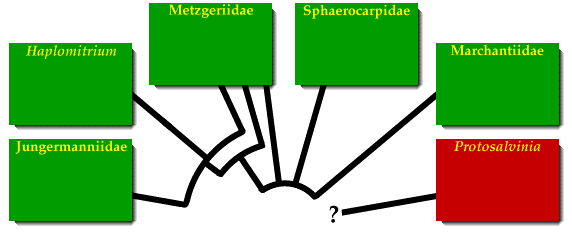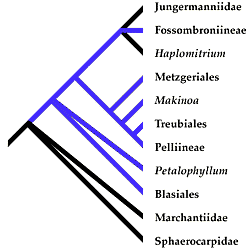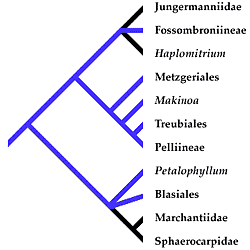







The liverworts are a group of plants that include about 6,000 to 8,000 species. Liverworts are the only major group of land plants that entirely lack stomata, specialized openings between cells that regulate air flow in and out of the plant. Because of this, the liverworts are believed to be the oldest surviving lineage of plants, with an independent history from all other plants. That is, once plants evolved, a major split occurred in their evolution, with one line producing the liverworts while the other evolved stomata and eventually gave rise to all other land plants that have ever existed.

The cladogram pictured above provides a summary of our current ideas about liverwort relationships. Liverworts are divided into two main groups: the Jungermanniopsida (including the three boxes on the left side of the cladogram) and the Marchantiopsida (including Sphaerocarpidae and Marchantiidae). To better understand the relationships, it may be helpful to discuss traditional ideas about relationships first. A summary of traditional liverwort classification appears below.
Hepaticophyta (Marchantiophyta)
Class : Marchantiopsida |
Liverworts are traditionally divided into two groups, with each group including
three subgroups. Two of these subgroups (Haplomitriales & Monocleales) each
contain only one genus with two species each. You may notice a difference in
the endings of the names if you compare the list at left with the cladogram
at the top of this page. This is because traditional classifications rank
the six subgroups as orders (with names ending in -ales), while the most
recent classification (Crandall-Stotler & Stotler, 2000) raises four of these
groups to the rank of subclass (with names ending in -idae).
Class definitions remain unchanged in the new classification.
In this new classification, the Haplomitriales are part of the Metzgeriidae. However, we have singled Haplomitrium out for a box of its own in the cladogram above, partly because of its unique combination of physical features and its traditionally separate status, but also because it may be the sister group (nearest relative) of the leafy liverworts (Jungermanniidae). The genus Monoclea is a problematic taxon, with two current hypotheses about its relationship to other liverworts, but it is now placed within the Marchantiidae. The additional taxon Protosalvinia is a fossil plant, whose true relationships are also a subject of much discussion. Because it has no living species, no one is really certain where it belongs. However, we have included it here with a red box and a question mark to indicate the uncertainty about its placement. |
 |
 |
Liverwort relationships : The cladograms above show two possible trees for the evolution of liverwort groups. The tree at left includes a split of the liverworts into its two traditional groupings (Jungermanniopsida & Marchantiopsida). The tree at right has the same pattern of branches, but places the "root" (origin) of the liverworts among the Metzgeriidae (simple thalloids). If the second hypothesis is correct, then the simple thalloids provide a better picture of what early liverworts were like. (The members of the Metzgeriidae have their branches in blue to help you distinguish them.)
The name Hepaticophyta/Marchantiophyta/"Hepatophyta"
Liverworts as "bryophytes" (Hepaticophyta, Anthocerotophyta, and Bryophyta), the sporophyte plant remains small and dependent on the parent gametophyte for its entire life.
Relationships within the Plantae. Systematics within the Plantae is based on a number of features in addition to life-cycle characteristics. The presence of stomata in all plants but the Hepaticophyta suggests that they were the earliest group to diverge.
For more information about the systematics of the land plants, visit the Tree of Life.
For more liverwort links, see the list of resources provided by the American Bryological and Lichenological Society


